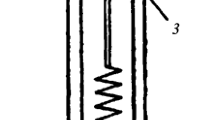Abstract
Atmospheric resid was treated with N-methylpyrrolidone in the presence of the undecane fraction at mass ratios to the feedstock of 3:1 and 0.5:1 with preliminary light deasphalting with and without pentane. As a result, the sulfur content in the atmospheric resid decreases by four times and the carbon residue decreases by two times. N-Methylpyrrolidone forms an azeotrope with undecane with a boiling point of 179°C, i.e., 25° lower than for the extracting agent. This allows decreasing the degree of its decomposition in regeneration and corrosion of the equipment.
Similar content being viewed by others
REFERENCES
O. B. Braginskii, Development of the World Oil Refining Industry under the Effect of Environmental Protection Requirements [in Russian], TsEMI, Moscow (2000).
E. F. Kaminskii and V. A. Khavkin, Exhaustive Refining of Crude Oil: Process and Environmental Aspects [in Russian], Tekhnika, TUMA GRUPP, Moscow (2001).
O. B. Braginskii and E. B. Shlikhter, World Oil Refining: Environmental Measurement [in Russian], Academia, Moscow (2002).
L. N. Shabalina, V. S. Edigarova, V. V. Sokolov, et al., Khim. Tekhnol. Topl. Masel, No. 2, 21–23 (1998).
A. N. Makukhn, Teploenergetika, No. 9, 3 (1989).
T. Kh. Melik-Akhnazarov, I. T. Kozlov, T. N. Mitusova, et al., Neftekhimiya, 31, No.2, 264–268 (1991).
P. V. Roslyakov, L. E. Egorova, and I. L. Ionkin, Process Measures to Reduce Harmful Emissions from TPP [in Russian], MEI, Moscow (2001).
V. E. Somov, in: Proceedings of the International Forum on the “Fuel-Power Complex in Russia: Regional Aspects,” St. Petersburg, April 2–5, 2002 [in Russian], St. Petersburg (2002), pp. 4–5.
S. A. Mel’nikova, T. L. Kandelaki, and I. A. Ermakov, The Residual Fuel Oil Market in the Russian Federation [in Russian], InfoTEKKonsalt, Moscow (2001).
S. F. Venner, Neftegaz. Tekhnol., No. 5, 89–95 (2000).
M. Khorram and T. Swaty, Oil Gas J., 100, No.48, 42–44, 46–47 (2002).
Erdol “Erdgas” Kohle, 117, No.12, 59–60 (2004).
Neftegaz. Tekhnol., No. 2, 59–60 (2004).
S. V. Meshcheryakov, Nauka Tekhnol. Uglevodorodov, No. 6, 158–166 (2000).
V. P. Tutubalina, I. G. Galiev, and Yu. G. Nazmeev, Enhancement of Chemical Processes in Refining of Petroleum Components [in Russian], Kazanskii Gosudarstvennyi Universitet, Nizhnekamsk (1997), pp. 102–103.
T. N. Mitusova, I. A. Pugach, and N. P. Averina, Khim. Tekhnol. Topl. Masel, No. 2, 6–7 (2001).
Neftegaz. Vertikal’, No. 18, 9–13 (2002).
V. E. Somov and D. E. Zlotnikov, Neftepererab. Neftekhim., No. 1, 3–8 (2003).
O. Makarov, Neft’ Rossii, No. 8, 14–15 (2000).
BIKI, No. 21–22, 2–4 (2004).
Russia in the World Oil Refining System in 1999 “Status, Problems, Prospects [in Russian], TsNIITEneftekhim, Moscow (1999).
V. G. Kuznetsov and D. B. Kadyrov, Khim. Tekhnol. Topl. Masel, No. 3, 7–8 (2003).
A. A. Gaile and V. E. Somov (eds.), Extraction Dearomatization of Petroleum Cuts. Research at INEF LLC [in Russian], Izd. S.-Peterburgskogo Universiteta, St. Petersburg (2002).
L. P. Kazakova and S. E. Krein, Physicochemical Principles of Production of Petroleum Lube Oils [in Russian], Khimiya, Moscow (1978).
Neftegaz. Tekhnol., No. 3, 45–46 (1995).
D. Bernabe, A. Romero-Martinez, and A. Trejo, Fluid Phase Equilib., 40, 279–288 (1988).
A. A. Gaile, G. D. Zalishchevskii, O. M. Varshavskii, et al., See [23], pp. 137–152.
A. A. Gaile, G. D. Zalishcheskii, O. M. Varshavskii, et al., Ibid., pp. 153–163.
V. B. Kogan, Azeotropic and Extractive Distillation [in Russian], Khimiya, Leningrad (1971).
P. Gierycz, M. Rogalski, and S. Malanowski, Fluid Phase Equilib., 22, No.1, 107–122 (1985).
J. Gmehling, J. Menke, and M. Schiller, Activity Coefficients at Infinite Dilution. DECHEMA Chemistry Data Series, Vol. 9, Pts. 3, 4, Frankfurt/Main (1994).
V. F. Kam’yanov, T. A. Filimonova, L. V. Gorbunova, et al., The Chemical Nature of the Components of Asphalt from West Siberian Mixed Crude Oil [in Russian], Tomsk (1984).
A. M. Aliev, Z. Yu. Karaeva, and E. P. Tardzhumanova, Sbornik Trudov Inst. Neftekhim.Protsessov Akad. Nauk AzSSR, No. 13, 129–132 (1982).
Author information
Authors and Affiliations
Additional information
__________
Translated from Khimiya i Tekhnologiya Topliv i Masel, No. 4, pp. 3 – 9, July – August, 2005.
Rights and permissions
About this article
Cite this article
Gaile, A.A., Kostenko, A.V., Zalischevskii, G.D. et al. Increasing the Quality of Furnace Residual Fuel Oils. Extraction Treatment with N-methylpyrrolidone. Chem Technol Fuels Oils 41, 249–259 (2005). https://doi.org/10.1007/s10553-005-0059-7
Issue Date:
DOI: https://doi.org/10.1007/s10553-005-0059-7




